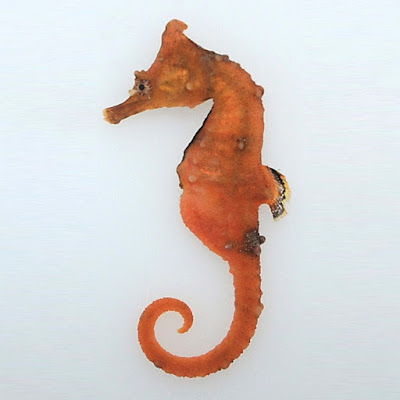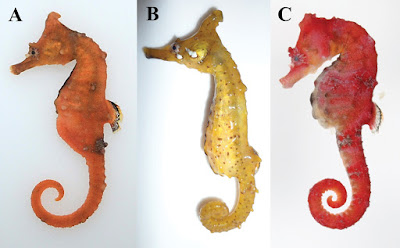![]() |
Hippocampus haema
Han, Kim, Kai & Senou, 2017
|
Abstract
Morphological and molecular analyses were conducted on 182 specimens belonging to the Hippocampus coronatus complex (H. coronatus sensu lato), collected in Korea and Japan 1933–2015, in order to clarify the taxonomic status of the species within this complex. Three species are recognized based on the shape of the coronet, the number of trunk rings (TrR) and tail rings (TaR), and presence or absence of a wing-tip spine (WS) at the dorsal fin base. Hippocampus coronatus Temminck & Schlegel, 1850 (H. coronatus sensu stricto), is diagnosed by 10 TrR, 37–40 TaR, an extremely high coronet (55.7–79.0 % head length) with four tips on the corona flat (CoT), and one WS. Hippocampus sindonis Jordan & Snyder, 1901 is diagnosed by 10 TrR, 35–38 TaR, a moderately high coronet (36.3–55.4 % HL) with five CoT, and no WS. A new species, Hippocampus haema is described on the basis of 140 specimens, characterized by 10 TrR, 35–38 TaR, a moderately high coronet (34.1–54.9 % head length) with four CoT, and two WS. Hippocampus haema is only known from the Korea Strait, western Kyushu, and East/Japan Sea. Recognition of the three species is supported by differences in mitochondrial DNA fragments (cytochrome b, 16S rRNA, and 12S rRNA).
Keywords: Genetic distance, morphology, molecular systematics, Pacific Ocean, taxonomy
![]() |
| Figure 4. Coloration of fresh specimens. A Hippocampus haema(paratype, PKU 9424) BH. coronatus (FAKU 137351) C H. sindonis (FAKU 137339). |
Hippocampus coronatus Temminck & Schlegel, 1850
English name: Crowned seahorse,
New Korean name: -haema, Japanese name: Tatsu-no-otoshigo
Diagnosis: A species of
Hippocampus having a bony body; double gill openings; ring (R: TrR + TaR) 10 + 37–40, mode 10 + 39 (lectotype: 10 + 38); extremely high coronet, straight or inclined backwards; CoT 4; CHGO 43.0–60.1 % HL; CHMC 55.7–79.0 % HL; WS thick and recurved.
Distribution: Southeastern coast of Honshu (Japan), from Izu Peninsula (Shizuoka Prefecture) to Boso Peninsula (Chiba Prefecture) (Fig. 1). Hippocampus coronatus lives in weed habitats, especially in floating Sargassum (Kuiter 2009; Senou 2013), within shallow areas (0–20 m depth).
Etymology: The Latin word
coronatus means
crowned. The new Korean name, Wanggwan-haema means ‘crowned seahorse’, in agreement with the English and scientific names. In fact, Haema, which has the connotation ‘common’ and ‘fish species belonging to the genus Hippocampus’ in Korean, has been used to name seahorses commonly found in Korea, whereas Wanggwan-haema has been informally used to refer to H. coronatus in Korean. In addition, the word wanggwan [crown] is more suited for H. coronatus, whose coronet is considerably higher than that of H. haema. The Japanese name Tatsu-no-otoshigo literally means ‘dragon’s bastard child’.
Hippocampus sindonis Jordan & Snyder, 1901
English name: Painted seahorse,
Korean name: Sindo-haema, Japanese name: Hanatatsu
Diagnosis: A species of
Hippocampus having a bony body; double gill openings; R 10 + 35–38 (holotype: 10 + 37); coronet moderately high; CoT 5; CHGO 26.8–41.0 % HL; CHMC 36.3–55.4 % HL; a very blunt or truncated spine on the dorsal fin base; no WS on dorsal fin base.
Distribution: Southeastern coast of Honshu (Japan), from Tanabe (Wakayama Prefecture) to Boso Peninsula (Chiba Prefecture) (Fig. 1).
Hippocampus sindonis lives in a wide range of habitats, from shallow high-energy algae reefs to soft bottom habitats (Kuiter 2009), at 2–30 m depth (Senou 2013).
Etymology: The specific name
sindonis was derived from the name of
M. Sindo, an assistant curator of fishes at Stanford University (Jordan and Snyder 1901; Lourie 2016). The English name was coined by Kuiter (2009). The Japanese name Hanatatsu literally means ‘hana (flower or blossom, which indicates gorgeous) + tatsu (dragon, or the abbreviation of the word “Tatsu-no-otoshigo: seahorse”)’, and refers to the beautiful color and skin filaments of the species.
![]() Hippocampus haema sp. n.
Hippocampus haema sp. n.
New English name: Korean seahorse,
Korean name: Haema, New Japanese name: Himetatsu
Hippocampus coronatus: Jordan and Snyder 1901: 19; Mori 1928: 5; Boeseman 1947: 195; Mitani 1956: 30; Chyung 1977: 272; Araga 1984: 89; Senou 1993: 489 (right fig.), 1294; Kim and Lee 1995: 76; Nakamura 1999b: 125; Senou 2000: 536; Choi et al. 2002: 141; Senou 2002: 536, 1508; Kim et al. 2005: 203; Choi et al. 2006; Yoshino and Senou 2008: 76; Kohno et al. 2011: 127; Senou 2013: 635, 1911; Han et al. 2014: 423 (non Temminck & Schlegel).
Hippocampus cf. coronatus: Kuiter 2009: 128.
Hippocampus sindonis: Nakamura 1999a: 124; Yoshino and Senou 2008: 76; Kim et al. 2013: 42 (non Jordan & Snyder).
Hippocampus kuda: Kim et al. 2001: 67, Myoung et al. 2002: 74 (non Bleeker).
Hippocampus sp.: Kim and Ryu 2017: 110.
Diagnosis: A species of
Hippocampus having a bony body; double gill openings; R 10 + 35–38, mode 10 + 36 (holotype: 10 + 36); coronet moderately high and turned back on top; CoT 4; CHGO 22.7–41.6 % HL; CHMC 34.1–54.9 % HL; a WS on the dorsal fin base.
Distribution: Korea: southern and southeastern coasts of the Korean Peninsula (from Soan Island to Ulsan); Japan: western coast of Kyushu (western Kagoshima Prefecture), northwestern coast of Honshu (from Kyoto Prefecture to Akita Prefecture) (Fig. 1). Lives in floating Sargassum and weeds on shallow soft bottom habitats from 0–18 m depth (e.g. Kim et al. 2016).
Etymology: The Korean word
Haema means ‘
seahorse’, which connotes ‘representative’ and ‘common’. Thus, the scientific and Korean names
Haema were chosen to indicate that this seahorse is the one most commonly found in Korea. The Japanese name Himetatsu means ‘princess seahorse’ or ‘dwarf seahorse’, and refers to its lower coronet and smaller body compared to
H. coronatus.







































































































